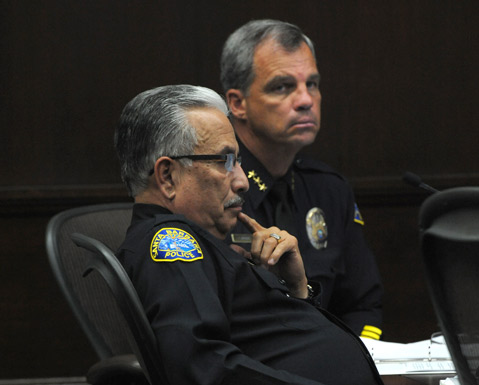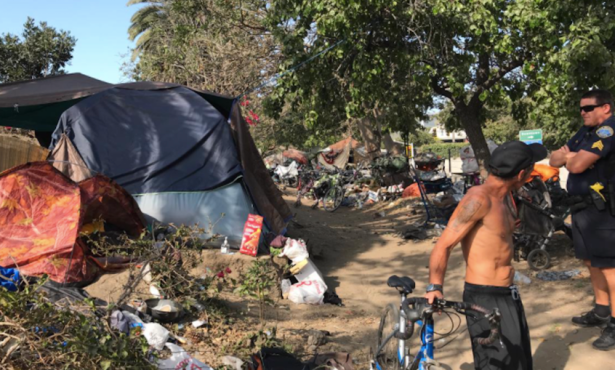Homeless Crime Wave: Perception or Reality?
Council Majority Pushes to Hire More Cops

Responding to escalating complaints from the business community about a transient-related crime wave, a narrow majority of the Santa Barbara City Council expressed strong support for hiring anywhere from six to 13 additional cops in hopes their presence will deter aggressive panhandling and other forms of uncivil behavior on State Street, Milpas Street, and along the waterfront. This demand comes at a time when more serious crime has been trending down for the past three years and City Hall is confronting a budget shortfall of $2.7 million. New police officers, on average, cost City Hall about $150,000 a year. Even so, four members of the council agreed that the 137 sworn police officers that the coming year’s budget would authorize is not sufficient. “A hundred and thirty-seven is not acceptable,” declared Councilmember Dale Francisco. “I can’t support a status quo budget; I will not support one; it will not happen.” Francisco said the council should strive to expand the force by 13 sworn officers during the next three years. Normally one of the council’s more outspoken fiscal conservatives, Francisco added, “I’m not sure where we will find the money, but I don’t really care where we get it from.”
Mayor Helene Schneider, representing the council’s more liberal minority, took exception to the “status quo” tag, contending that if the proposed budget were approved, there could be as many as 20 more bodies on the ground fighting crime than there were two years ago. The current budget, she noted, would add eight new cops to the force beyond the number there in 2010. In addition, City Administrator Jim Armstrong has proposed spending $352,000 of Redevelopment Agency (RDA) funds in part to fund one extra full-time cop to deal exclusively with the homeless. (There’s one now.) The money would also allow City Hall to hire three outreach workers to connect the homeless with social services, and to pay for six “social hosts” to patrol State Street, the waterfront, and Milpas Street to limit unruly and obnoxious behavior that falls short of being illegal. Armstrong, though, explained that using the $352,000 in RDA funding would push the envelope of redevelopment law and that the RDA might not survive Jerry Brown’s budget. Schneider suggested two additional sworn officers could be taken off desk jobs and put into the field by reassigning their administrative functions to non-sworn employees. She also said if people want more cops, they should consider putting a tax on the ballot. She put this out there as a possible idea, not necessarily one she could or would get behind.
Schneider and councilmembers Grant House and Bendy White expressed concern about what other city programs would have to be cut back in order for the Police Department to expand. At a time of escalating retirement costs and uncertain revenues, they asked, did City Hall want to take on such a sizable obligation? The Police Department last had 150 officers authorized in 2001, thanks in large measure to federal grant funds that have long since evaporated. Back then, wages and benefits for cops cost City Hall $17 million; today it’s $28 million. Back then, public safety — police and fire protection — consumed 45 percent of the city’s General Fund; today, it’s 54 percent.
Packing the council chambers Monday evening were off-duty cops active in the Police Officers Association (POA) and their families. The union has long contended that City Administrator Jim Armstrong has systematically cut police positions — down to just 121 two years ago — putting officers at risk and sacrificing public safety. Members of the POA met earlier Monday with activists involved with the Milpas Community Association (MCA), telling them that money for extra cops could be found if only Armstrong decided he wanted to find it. Police response times have gone up in recent years, particularly for second- and third-tier crimes. Hotel owner Tony Romasanta delivered a passionate demand for 150 cops. “That’s what we need; that’s what we want; that’s what we all deserve,” he thundered, to loud applause. A woman active in the “destination management” industry described how one visitor was traumatized while dining outdoors when a homeless man reached across the outdoor railing and snatched food off her plate. No one mentioned gangs, youth violence, or other forms of crime.
A handful of Eastside residents and activists — concerned the MCA expresses too much the point of view of business people and not enough the point of view of the community — showed up to argue the other side, that City Hall’s limited funds would be better spent on after-school and summer programs for kids than on new police officers. One mental-health advocate decried the lack of mental-health and detox beds available now to help people struggling with the dual affliction of addiction and mental illness.
Perhaps most striking was the decided shift in posture adopted by Police Chief Cam Sanchez, far more outspoken in his support for more resources than he’s been during budget deliberations during the last three years. In the past, Sanchez espoused the cuts pushed by his boss, City Administrator Jim Armstrong, but on Monday he challenged the City Council — dominated by a new, more conservative majority since January — to articulate what level of service it wanted. “To be a full service department and address the needs of the community,” he declared, “we need more resources.” (In recent years, the department has cut its number of beat coordinators from six to two, and suspended its DARE, or Drug Abuse Resistance Education, program.) To Eric Beecher, president of the POA, that was nice, but not good enough. “I think the chief was trying to say he wanted more police officers,” Beecher told the councilmembers. Moments later, Sanchez replied he couldn’t have been more clear if he had stood on a table and screamed. “I need more people,” he stated, “but I’m not going to stand on the table.”



